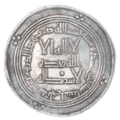Dirham facts for kids
Dirham is a unit of currency in several Arabic-speaking nations, including:
- The Moroccan dirham
- The United Arab Emirates dirham
- 1/1000 of the Libyan dinar
- 1/100 of the Qatari riyal
- 1/10 of the Jordanian dinar
- The dirham, spelt 'diram,' is 1/100 of the Tajikistani somoni.
Historically, the word "dirham" is comes from 'dirhem' which comes from the name of a Greek coin, the Drachm; the Byzantine Empire controlled the Levant and traded with Arabia, circulating the coin there in pre-Islamic times and afterward. It was this currency which was first used as an Arab word. Near the end of the 7th century, the coin became an Islamic currency. It had the name of the sovereign and a religious verse on it. The dirham was used by many Mediterranean countries, including Spain. It could be used as currency in Europe between the 10th and 12 centuries.
Similar currencies
The Armenian dram is a currency whose name bears a similar origin. The dinar is a currency used in the Muslim world but originating with the Romans.
Images for kids
-
Silver Dirham of Caliph 718–719 CE Umar ibn Abd al-Aziz
-
Silver dirham of Yazid II minted in 721–722 CE
-
Silver Dirham of Marwan II ibn Muhammad 749–745 CE
-
Silver Dirham of As-Saffah 754–758 CE
-
Silver Dirham of Al-Hadi minted in 786–787 CE in al-Haruniya
-
Silver dirham of Al-Mu'tasim, minted at al-Muhammadiya in 836–837 CE
-
One of the first silver coins of the Umayyad Caliphate, still following Sassanid motifs, struck in the name of al-Hajjaj ibn Yusuf
-
Later silver dirham of the Umayyad Caliphate, minted at Balkh in 729–730 CE (AH) 111)
-
Silver hoard from Lublin-Czechów, comprising 214 silver dirhams issued between 711-712 and 882-883 CE, Lublin Museum.
See also
 In Spanish: Dírham para niños
In Spanish: Dírham para niños










